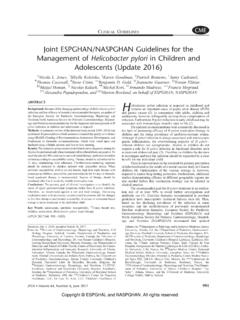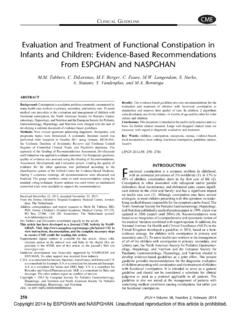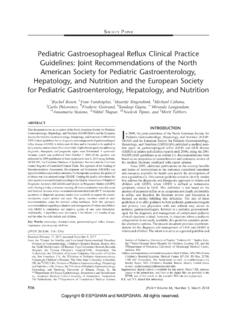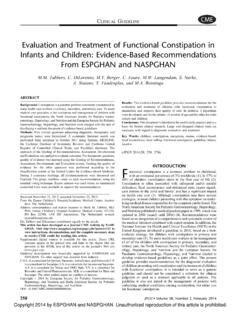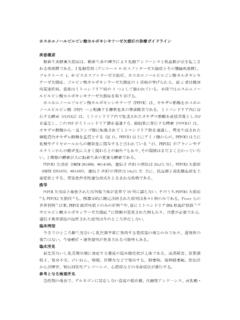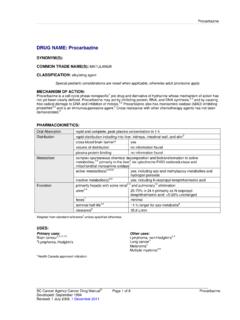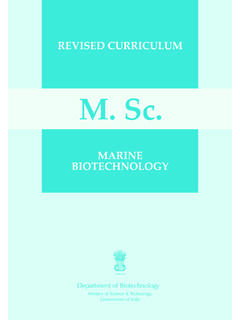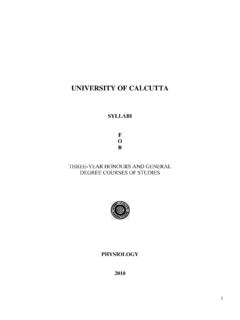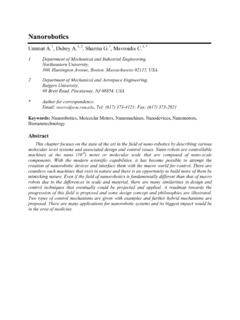Transcription of Evaluation of the Child With Suspected Mitochondrial Liver ...
1 Copyright 2013 by ESPGHAN and NASPGHAN. Unauthorized reproduction of this article is of the Child With SuspectedMitochondrial Liver Disease Jean P. Molleston,yRonald J. Sokol,zWikrom Karnsakul, Alexander Miethke,jjSimon Horslen, John C. Magee,#Rene Romero, Robert H. Squires, andyyJohan Van Hove,for the Childhood Liver Disease Research Education Network (ChiLDREN)Key Words:DGUOK, genetics, inborn errors of metabolism, Liver disease, Liver failure, Mitochondrial disease, Mitochondrial hepatopathy, MPV17,POLG(JPGN2013;57: 269 276)This review was developed by the Mitochondrial Liver Dis-eases Working Group of the Childhood Liver DiseaseResearch and Education Network, supported by the National Insti-tute of Digestive, Diabetes and Kidney Diseases, National Institutesof Health, to guide Evaluation of children with Suspected mito-chondrial Liver disease.
2 Data informing the Evaluation guidelinewere supported by MEDLINE searches of published English-language literature and expert opinion from a committee ofpediatric hepatologists and a Mitochondrial metabolism respiratory chain defects can affect any tissue,with the most energy-dependent organs being most vulnerable (1).In general, clinical manifestations include multisystem involvementsuch as brain, muscle, heart, or kidney, with acute or chronic liverdysfunction, sometimes in the presence of lactic acidosis, abiomarker of limited sensitivity (2,3). Heterogeneous clinical pre-sentations can be explained by the fact that the mitochondrialquantity and function are uniquely influenced by both nuclearand mitochondria DNA (mtDNA) or by the fact that cells in varioustissues can contain different mixtures of normal and abnormalmitochondrial genomes (heteroplasmy).
3 Most mitochondrialproteins and enzymes are coded by nuclear genes with Mendelianinheritance, whereas some respiratory chain subunits, ribosomalRNAs, and transfer RNAs are encoded by Mitochondrial genes thatare maternally inherited (4). Mutations, deletions, or duplications ineither of these classes can cause disease, and mutations in nucleargenes that control Mitochondrial DNA replication, transcription,and translation may lead to mtDNA depletion syndrome or to atranslational disorder (5 7).The respiratory chain, consisting of 5 multimeric complexes(I V) in the Mitochondrial inner membrane, generates energy asadenosine triphosphate via electron transport and oxidative phos-phorylation (Fig.)
4 1). Defects in the respiratory chain enzymes ormitochondrial membrane transport proteins result in injury toenergy-dependent organs, especially brain, retina, muscle, heart,and Liver (8). In addition, hepatic mitochondria oxidize fatty acidsforming ketone bodies, an important source of energy for the brainin the fasting state. Fatty acid oxidation defects, an important groupof primary bioenergetic defects, can present similarly with hepato-pathy or encephalopathy, often with nonketotic hypoglycemia,acidosis, and hyperammonemia, and are thus included in thedifferential diagnosis and should be simultaneously evaluated (9).Establishing the diagnosis of primary Mitochondrial bioe-nergetic defects in patients with Liver disease requires a high indexof suspicion in specific clinical scenarios.
5 A tiered diagnosticevaluation is useful (Table 1). Although Mitochondrial hepatopa-thies are a heterogeneous group of disorders, there are severalgeneral laboratory investigations in blood and urine that can revealan altered redox status suggestive of respiratory chain defects(lactate:pyruvate molar ratios and ketone body ratios). Specificlaboratory tests are considered in patients with unique clinicalpresentations as well, and either tissue analysis or genotyping isused to identify the etiology. Other typically involved organsystems should be evaluated when Mitochondrial hepatopathy issuspected (Table 2). Several important management issues shouldbe addressed during this Evaluation process.
6 These guidelines out-line the Evaluation of the infant or Child with Suspected mitochon-drial hepatopathy. Two summary tables (Tables 3 and 4) describingeach genetic etiology follow. Reference clinical laboratories for thegenetic tests can be found SCENARIOS SUGGESTING POSSIBLEMITOCHONDRIAL Liver DISEASEM itochondrial Liver disease can present acutely in a childwith no history of hepatic dysfunction, or with chronic Liver andReceived March 8, 2013; accepted May 29, the Section of Pediatric Gastroenterology, Hepatology, andNutrition, Indiana University School of Medicine, Indianapolis, IN,theySection of Pediatric Gastroenterology, Hepatology and Nutrition,University of Colorado School of Medicine, Aurora, CO, thezDepartment of Pediatric Gastroenterology and Nutrition, Johns HopkinsUniversity School of Medicine, Baltimore, MD, the Division of Gas-troenterology, Hepatology and Nutrition, Cincinnati Children s HospitalMedical Center, Cincinnati, OH, thejjDivision of Gastroenterology andHepatology, Seattle Children s Hospital, Seattle, WA, the Section ofTransplant Surgery.
7 University of Michigan Medical School, Ann Arbor,MI,#Pediatrics, Hepatology, and Liver Transplantation, Emory Univer-sity School of Medicine, Atlanta, GA, the Division of PediatricGastroenterology and Hepatology, University of Pittsburgh School ofMedicine, Pittsburgh, PA, and theyyDepartment of Pediatrics, Section ofGenetics, University of Colorado, School of Medicine, Aurora, correspondence and reprint requests to Jean P. Molleston, MD,Riley Hospital for Children, Indianapolis, IN 46202 (e-mail: by NIH Grants: Indiana University School of Medicine,U01DK084536; University of Colorado Denver/Children s HospitalColorado, U01 DK062453; Johns Hopkins University School of Medi-cine, U01 DK062503; Cincinnati Children s Hospital Medical Center,U01 DK062497; Seattle Children s Hospital, U01 DK084575; Univer-sity of Michigan Medical School, U01 DK062456; University of Pitts-burgh School of Medicine, U01 DK062466.)
8 Emory University School ofMedicine, U01 authors report no conflicts of #2013 by European Society for Pediatric Gastroenterology,Hepatology, and Nutrition and North American Society for PediatricGastroenterology, Hepatology, and NutritionDOI: Volume 57, Number 3, September 2013269 Copyright 2013 by ESPGHAN and NASPGHAN. Unauthorized reproduction of this article is 1 NADHH+H+H+H+H+NAD+CoQCoQH2 Succinate FumarateCyt cOxCyt cRedO2H2 OComplex 2 Complex 3 Complex 4 ADPPiATPC omplex 5 ETFDHETFFADH2 AcylCoA dehydrogenaseGlycerol-3-PdehydrogenaseFI GURE respiratory chain, consisting of 5 multimeric complexes (I V) in the Mitochondrial inner membrane, generates energy asadenosine triphosphate (ATP) via electron transport and oxidative 1.
9 Tiered approach to Evaluation of Suspected Mitochondrial diseaseTier1 Early screeningComprehensive metabolic profile, INR,a-fetoprotein, CPK, phosphorus, complete blood cell count, and ammoniaLactate/pyruvate, ideally obtained 1 hour after feeding (normal molar ratio is<20, normal postprandial lactate< mmol/L)Serum ketone bodies: both quantitative 3-hydroxybutyrate and quantitative acetoacetate (3-hydroxybutyrate/acetoacetate ratio<4 is normal) andtotal free fatty acids to calculate ketone bodies: free fatty acid ratio (10)Serum acylcarnitine profile; serum-free and total carnitinesUrine organic acids (look for elevated lactate, succinate, fumarate, malate, 3-methyl-glutaconic or 2-hydroxyglutaric, 2-ketoglutaric,methylmalonic acid)Serum amino acids (look for elevation of alanine [abnormal>500mmol/L, but more specific if>600mmol/L)Consider: Quantitative 3-methylglutaconic acid (serum or urine) (11)Urine acylglycines and 2-ethylmalonic quantification (if multiple acyl-CoA dehydrogenase deficiency is Suspected )Thymidine (plasma) (especially in cases with coexistent intestinal dysmotility concerning for MNGIE syndrome)Coenzyme-Q levels in leukocytes, not serum (for CoQ deficiency.)]
10 Leukocyte levels correlate better with tissue CoQ levels, whereas serum levelsreflect nutritional status)Quantitative serum methylmalonic acid (elevated in SUCLA and SUCLG1 deficiencies)CSF analysis: lactate and pyruvate (if blood lactate is normal but evidence of CNS involvement), amino acids (especially elevated CSF alanine), andprotein concentration (note CSF protein can be elevated in POLG1 disease early on, even when lactate is normal)2 Genotyping for more common genesMost common with Liver involvement:POLG1(12,13),DGUOK(14 16),MPV17(17,18),SUCLG1(19), C10 ORF2/TWINKLE(20), TRMU(28,29) (see Tables 3 and 4)If neuromuscular features suggest MELAS or pancreatic insufficiency suggests Pearson marrow/pancreas syndrome: Mitochondrial DNA pointmutations/deletions (21)If methylmalonic acid is elevated:SUCLG1(19)If acylcarnitines and/or urine organic acids suggest specific FAO defects: genotyping for LCHAD (22), CPTI and II deficiency (23,24), or(MADD glutaric acidemia II ETF and ETF-DH deficiency) (25),SLC25A20for CACT deficiency (26)For recurrent acute Liver failure:TRMU, ACAD9, CPTI, SUCLGI(19,23,27,28).

